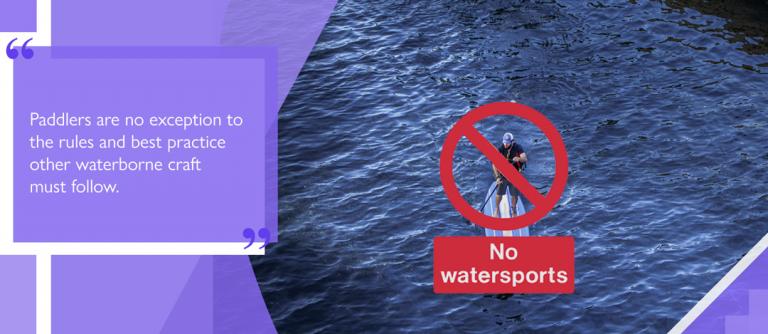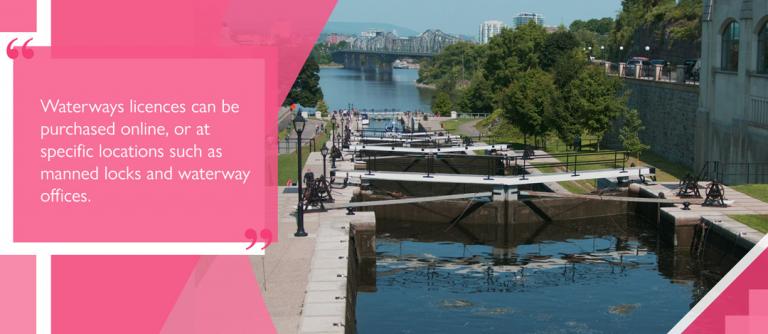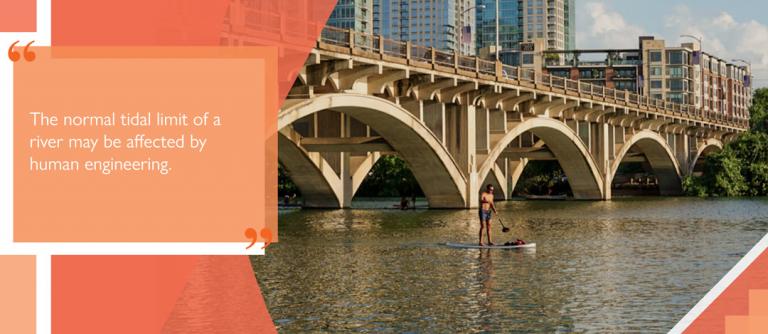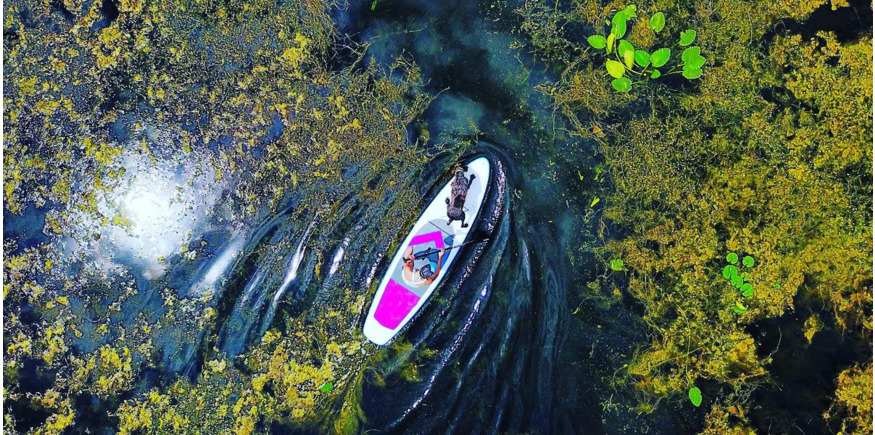Whether you choose to relax on a local reservoir, tour a meandering river, or surf the wild waves of the open sea, navigating a body of water safely and confidently is part and parcel of the paddleboarding experience.
But getting from location A to point B is not the extent of ‘navigation’. When you are out on a stand up paddle board, you are operating a craft among a community of water users — be they swimmers, anglers, other paddlers, barge operators, or sailors.
While it’s important to be aware of your intended route and location, you also need to consider how you plan to access the water, and be mindful of anyone or anything out there that you would rather not collide into. Damaging your inflatable stand up paddle board would certainly be a pain.
SUP route planning
In the traditional maritime sense, ‘navigation’ refers to ‘the passage of a craft across water’. This encompasses a variety of considerations a paddler may encounter prior to or during a trip or crossing, not just wayfinding.
If you are looking for information about plotting a route, our ‘Apps for SUP’ blog post goes into detail about progress tracking and mapping apps for smartphones. On a desktop or laptop, you may wish to try a web-based resource such as Go Paddling’s PaddlePoints microsite.

Rights and regulations on the water
Navigating a body of water is closely associated with the rights and responsibilities of the craft’s owner or pilot. This can include:
- what waters the vessel is permitted to enter,
- how the crew should position the craft relative to other people,
- how to negotiate obstacles while in motion.
Paddlers are no exception to the rules and best practice other waterborne craft must follow.
As paddleboarding is a ‘portable’ recreational activity that can take anywhere, it is important to do a little research if you plan to paddle away from your usual haunts.
Accessing a river or canal
Heading to a navigable waterway, like a river or a canal, will seem like a perfect paddle boarding environment. However, it’s worth bearing in mind that some rivers and canals are not open for public use. Being able to get onto a waterway without hinderance, doesn’t necessarily mean you have the right to be on it.
Waterways licensing
Most British waterways that are rightfully accessible to paddlers will be governed by an overseeing authority. Typically, this will be a national organisation, such as the Canal and River Trust or Environment Agency, a regional body, or local council.
To make use of the thousands of miles of waterways on offer, you will need to obtain a licence. There is no need to pass a test — you can just buy one from the corresponding authority.
Waterways licences can be purchased online, or at specific locations such as manned locks and waterway offices.
Licences can cover a range of time periods to suit your needs, from one day to one year.
The advantages of British Canoeing membership
Given that there are many regional waterways authorities, the cost of obtaining licences for multiple trips or visiting multiple locations can add up – especially if you like to paddle regularly.
To keep costs and effort to a minimum, it is usually recommended that paddleboarders either living in or paddling in England obtain a waterways licence by becoming a member of British Canoeing.
A similar facility is available to members of Canoe Wales for Welsh paddlers.
Waterways in Scotland operate under a different legal concept, known as the freedom to roam. The main difference is that you do not need a licence to paddle on a Scottish river or canal.
British Canoeing has a licensing arrangement in place with a broad range of waterways authorities. In addition to providing you with craft insurance, a £45 annual membership will cover you in lieu of an individual licence for:
- All Canal and River Trust waterways
- All Environment Agency managed waterways
- Broads Authority waterways (in the Norfolk Broads region)
- Many local and regional canal and river authorities not covered under the above
Because the number of authorities is extensive, we would urge you to check the British Canoeing website for a complete list.
If a waterway you wish to use is not listed, this could indicate a licence is not needed (there are some places that fall into this category). However, there is also a good chance that paddling is simply prohibited.
It should also be noted that British Canoeing licensing agreements are not universally geared to permitting use of the waterways for stand-up paddleboards. Check before you buy (or go) whether you can bring a board to a specific location.

Why is a waterways licence needed?
Licensing provides revenue for waterway maintenance. A variety of activities managed by waterways authorities — such as debris removal and bank erosion repairs — are funded through licensing.
If you make use of a licensed waterway without a licence, you could end up receiving a fine.
While out on the water, you will be expected to have your British Canoeing card, or proof of being licensed, with you.
Exceptions to the licensing programme
Tidal rivers and Public Right of Navigation (PRN)
Any region of a river, extending from the point where it meets the sea (i.e. the estuary) up to the ‘natural tidal limit’ is free to use without a licence. The stretch of a waterway this affects is said to be covered under a historic legal right, known as Public Right of Navigation (or a ‘PRN’ for short.)
Identifying the ‘tidal limit’
Ordnance Survey maps indicate where the normal tidal limit is reached. However, the natural tidal limit may extend beyond this, especially if the normal limit is caused by human engineering (e.g. bridges, dams, etc.) Again, some research before you go will help.
Inland waterways covered by a PRN
It’s not just tidal rivers — some non-tidal rivers are also covered by a PRN.
British Canoeing lists the following waterways as being free for all paddlers:
- Exeter Ship Canal
- River Severn – upstream of Stourport
- River Wye (Wales/South West England) – downstream of Hay on Wye
- River Little Ouse – Thetford to Brandon
- River Cam – from Grantchester to Bishops Mill Sluice (Silver Street), Cambridge
- River Rother (East Sussex) downstream from Robertsbridge
- Royal Military Canal
In addition, some rivers in the Lake District do not require a licence.
Contested waterways
While thousands of miles of canals and rivers in England are covered under a variety of arrangements, a vast amount is not open to public use. Typically, this will be due to adjacent landowners staking a claim, or other private vested interests and concerns. For example, fishing rights are a potential reason for objection to public right of way.
Lakes and reservoirs
Enclosed bodies of water, such as lakes and reservoirs, are not considered a part of the waterways network. They will have their own access arrangements. Check with any clubs, authorities, or utilities that may hold responsibility.
Coastal regions and the open sea
Tidal estuaries and coastlines are covered under PRN; you do not need a licence to paddle in these areas.
That said, if you are paddling near a marina or shipping port, there is a good chance that a port authority may have responsibility for shipping channels and waters in the vicinity.
Crossing port channels, marked by red and green buoys, will be prohibited. In any case, it is potentially dangerous and should be avoided.

Priority and best practice on the water
At some point, you are likely to encounter another paddler or craft out on the water. Negotiating these moments requires a level head. Here are some general tips:
- Stay out of busy shipping channels. Try to stay to the side of these where possible.
- Be wary of any craft that cannot move or change direction quickly, i.e. slow, larger vessels.
- Remember that sailboats may need to zigzag (tack) to make headway. You should give way to any sailboat you meet for this reason.
- Small motorised craft should give way to you. They must give you a wide berth.
- If another craft, such as a motorised boat, attempts to overtake, it’s best to maintain your direction and speed.
- If you get caught in the wake of a passing vessel, kneeling on your board may help you to maintain stability.
- It’s important that other craft operators can see you. High-vis gear can help with this.
- Avoid areas of water with lots of swimmers.
Heading out to navigable waters?
There are plenty of waterways, lakes, reservoirs, and coastal seas to explore on an inflatable paddleboard. Why not get out there and discover an unexpected adventure?
If you need an inflatable SUP or kit to help you make the most of your journeys, then start with some high-quality gear from Two Bare Feet. We have a wide range of SUP boards, accessories and wetsuits to suit all disciplines and skill levels: from beginners to experts, and riders of all ages.
Need help making a choice? Get in touch with the Two Bare Feet team! Our experienced and friendly staff can’t wait for you to discover the pleasures of stand up paddleboarding on your terms.




